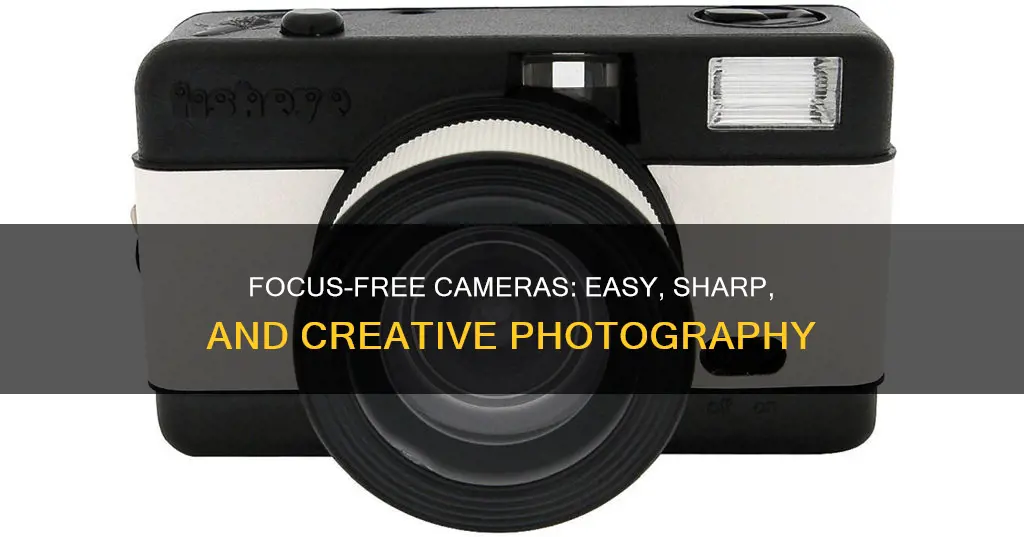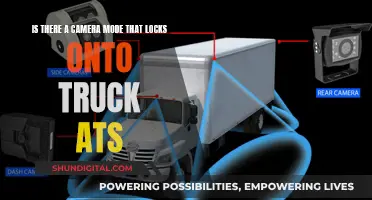
A focus-free camera, also known as a fixed-focus camera, is a camera that does not require the user to adjust the focus. The focus is set at the time of lens design and remains fixed, usually at the hyperfocal distance, so that the depth of field ranges from half that distance to infinity. This allows the camera to capture acceptably sharp images within a certain range of distances without the need for manual focus adjustment. Focus-free cameras are typically found in low-end and inexpensive cameras, such as disposable cameras and point-and-shoot cameras, and are a great choice for beginners or those who want a simple and easy-to-use photography experience.
| Characteristics | Values |
|---|---|
| Focal point | Fixed at its hyperfocal distance |
| Focusing | No need to adjust the focus |
| Aperture | Small |
| Image quality | Acceptably sharp images |
| Use | Cheapest cameras, disposable cameras, low-end point-and-shoot cameras, webcams, surveillance cameras, camera phones, aerial photography |
| Cost | Very inexpensive |
| Ease of use | More predictable than automatic systems |
| Image quality | Less sharp than a lens that has been set to the best focal point for a scene |
| Limitations | Unable to produce sharp images of objects close to the camera (within 8-12 feet), unsuitable for portraits |
What You'll Learn

Focus free vs fixed-focus
A focus-free camera is a base version of a digital camera that captures photographs within a certain range of distances without needing to adjust the focus. Fixed-focus and autofocus cameras are higher versions of focus-free cameras. While autofocus cameras automatically adjust the focus according to the picture and light conditions, fixed-focus cameras have a lens whose focus is set at the time of design and remains unchanged.
Focus-Free vs Fixed-Focus
The main difference between focus-free and fixed-focus cameras is that focus-free cameras are a broader category that includes fixed-focus cameras. Fixed-focus cameras are a type of focus-free camera. Both camera types are designed to capture images within a certain range of distances without the need for manual focus adjustment.
Focus-free cameras are often used interchangeably with fixed-focus cameras because both types have a non-adjustable focus. The focus is typically set to the hyperfocal distance, allowing the depth of field to range from half that distance to infinity. This makes them suitable for capturing images of humans or objects larger than a meter.
Fixed-focus cameras, unlike autofocus cameras, do not have moving parts or require input from the operator. They are always focused to infinity, while autofocus cameras can focus on distances ranging from almost zero to infinity. The autofocus system uses mechanical movement to adjust the lenses and sharpen the desired point or area of the photograph.
Another distinction is that fixed-focus cameras are often used in low-end, inexpensive cameras, such as disposable cameras and low-end point-and-shoot cameras. They are also suitable for special-purpose cameras, like those used for aerial photography, where the distance of the subject from the camera is significant. Fixed-focus lenses are commonly found in low-resolution CCD cameras, such as webcams, surveillance cameras, and camera phones, due to their lower image quality requirements.
In summary, focus-free cameras encompass a wider range of camera types, including fixed-focus and autofocus options. Fixed-focus cameras offer a cost-effective solution with a simple, fixed lens design, while autofocus cameras provide more flexibility in focusing capabilities but are more complex and mechanically adjustable.
Street Camera Tickets: How Long Before They Arrive?
You may want to see also

Advantages of focus-free cameras
A focus-free camera is a base version of a digital camera. It has a fixed focal point at its hyperfocal distance and relies on depth of field to produce acceptably sharp images. Here are some advantages of using a focus-free camera:
Ease of Use
Focus-free cameras are easy to use as they do not require any manual adjustment of the lens. This makes them ideal for beginners or people who want a simple, point-and-shoot camera. The system is effectively automatic, relieving the photographer of the task of focusing.
Predictability
Focus-free cameras are more predictable than automatic systems. The fixed focal point means that users can rely on the camera to produce consistently sharp images within a certain range of distances.
Simplicity in Design
Focus-free cameras have a less complex design compared to automatic or manual systems. This simplicity makes them more affordable and accessible to a wider range of users.
Cost-Effectiveness
Focus-free cameras are typically more cost-effective than cameras with manual or automatic focus. This makes them a great option for those on a budget or those who are new to photography and don't want to invest a lot of money in their first camera.
Speed and Convenience
With a focus-free camera, there is no need to spend time adjusting the focus, allowing users to capture moments quickly and conveniently without missing a shot due to focusing issues.
Thermal Vision: Making of Thermal Cameras
You may want to see also

Disadvantages of focus-free cameras
A focus-free camera, also known as a fixed-focus camera, has a lens with a fixed focal point, usually set to the hyperfocal distance. This means that the camera relies on depth of field to produce acceptably sharp images, rather than adjusting the focal point for each scene. While this type of camera has advantages, such as being inexpensive and easy to use, there are also several disadvantages:
Image Sharpness
Focus-free cameras produce images that are not as sharp as those taken with a lens that has been manually focused or autofocused. This is because the lens is set to a fixed focal point, which may not be the optimal focal point for a given scene. As a result, images may appear slightly blurry or less detailed, especially when photographing objects that are close to the camera.
Limited Close-up Capability
Due to the fixed focal point, focus-free cameras are unable to produce sharp images of objects that are very close to the lens. This is a limitation for photographers who wish to capture close-up or macro photography, as the minimum focusing distance for these cameras is typically around 8-12 feet.
Inappropriate for Portraits
The fixed focal point of a focus-free camera makes it challenging to fill the frame with a person's face while also keeping it in sharp focus. As a result, these cameras are not ideal for portrait photography, as they cannot capture sharp and detailed images of faces at a typical portrait distance.
Reduced Light Intake
Focus-free cameras typically have a small aperture, which increases the depth of field but reduces the amount of light that reaches the film or sensor. This makes them less suitable for low-light conditions or for capturing fast-moving objects that require short exposure times to freeze motion.
Limited Creative Control
With a focus-free camera, the photographer cannot manually adjust the focal point to achieve specific creative effects. This lack of control can be limiting for photographers who wish to experiment with different focusing techniques or achieve a particular artistic vision.
Opening Adobe Camera Raw: A Step-by-Step Guide
You may want to see also

Focus-free cameras and aperture
A focus-free camera, also known as a fixed-focus camera, is a camera that does not require the user to adjust the focus. The focus is set at the time of lens design and remains fixed, usually at the hyperfocal distance. This means that the depth of field ranges from half that distance to infinity, allowing for acceptably sharp images without the need for focus adjustment.
Most cameras with focus-free lenses have a relatively small aperture, which increases the depth of field. The aperture and focal length of the lens are reduced to make the hyperfocal distance small, allowing the depth of field to extend from a short distance to infinity. This results in a reduction in the amount of light that reaches the film or sensor, as the smaller aperture lets in less light. Therefore, these types of lenses are usually not suitable for capturing fast-moving objects or situations that require short exposure times.
Focus-free cameras are typically found in low-end, inexpensive cameras such as disposable cameras and point-and-shoot cameras. They are also commonly used in special-purpose cameras, such as those used for aerial photography, where the distance between the camera and the subject is large, eliminating the need for focus adjustment. Additionally, they are suitable for low-resolution CCD cameras, like webcams and camera phones, as the low resolution allows for loose focusing without a noticeable loss in image quality.
The main advantage of focus-free cameras is their simplicity and cost-effectiveness. They are ideal for beginners or users who do not want to worry about adjusting the focus. However, one of the disadvantages is the inability to produce sharp close-up images, particularly for objects that are within a certain distance from the camera (typically around 8-12 feet). This makes them unsuitable for certain types of photography, such as portraits, where the subject needs to fill the frame and be in sharp focus.
Japan-Made Cameras: A Comprehensive Brand Guide
You may want to see also

Focus-free cameras for beginners
Focus-free cameras are a great option for beginner photographers. These cameras are designed to capture images within a certain range of distances, eliminating the need for manual focus adjustment. This makes them an excellent choice for those new to photography, as you can focus on composing your shot without worrying about technical complexities.
A focus-free camera, also known as a fixed-focus lens camera, has its lens set at a fixed focal point, typically the hyperfocal distance. This means the depth of field extends from half that distance to infinity, ensuring that objects within this range will appear acceptably sharp in your photographs. The small aperture of focus-free lenses further increases the depth of field, allowing for a broader range of sharp focus.
Benefits of Focus-Free Cameras
One of the most significant advantages of focus-free cameras is their cost-effectiveness. They are usually more affordable than cameras with autofocus or manual focus capabilities. Additionally, focus-free cameras are incredibly user-friendly. You don't need to worry about adjusting the focus, making them ideal for capturing moments quickly and spontaneously. They are also beneficial for individuals who wear eyeglasses, as there is no need to adjust the lens manually.
Limitations of Focus-Free Cameras
While focus-free cameras offer simplicity and convenience, they have some limitations. One notable drawback is their inability to produce sharp close-up images or photographs of objects very near the camera (usually within 8-12 feet). This makes them unsuitable for certain types of photography, such as portraits or macro photography, where a sharp focus on nearby subjects is essential. Additionally, focus-free cameras may struggle with fast-moving objects due to the small aperture, which reduces the amount of light reaching the film or sensor.
Examples of Focus-Free Cameras
Focus-free cameras are commonly found in low-end and inexpensive camera models, including disposable cameras and point-and-shoot cameras. The 35mm Focus Free camera, for example, is a simple plastic camera with a fixed-focus lens and no exposure controls. Despite its basic features, it can capture surprisingly good images, demonstrating the accessibility and ease of use that focus-free cameras offer to beginner photographers.
The Evolution of Cameras: Step-by-Step Guide
You may want to see also
Frequently asked questions
A focus-free camera is a camera with a fixed-focus lens, meaning the focal point is set at the time of lens design and remains unadjustable by the user.
Focus-free cameras rely on depth of field to produce acceptably sharp images. They usually have a small aperture, which increases the depth of field.
Focus-free cameras are inexpensive, easy to use, and suitable for beginners. They are also beneficial for people who wear eyeglasses, as there is no need to manually adjust the focus.
Focus-free cameras cannot produce sharp close-up images of objects within 8-12 feet of the camera. They are also not suitable for portraits or capturing fast-moving objects.
Focus-free cameras are typically found in low-end and inexpensive cameras, such as disposable cameras, point-and-shoot cameras, and camera phones. An example of a focus-free camera is the 35mm Focus Free, a simple plastic camera made in China and released around 2003.







